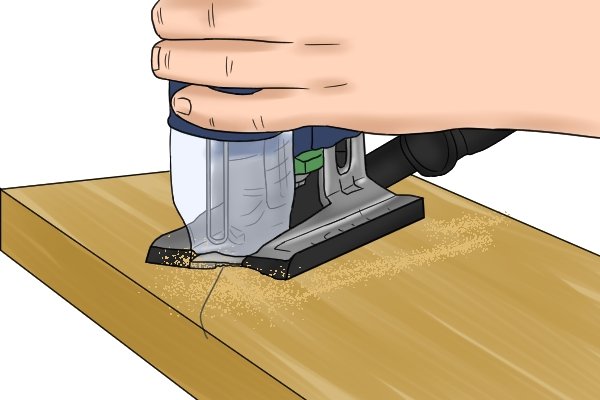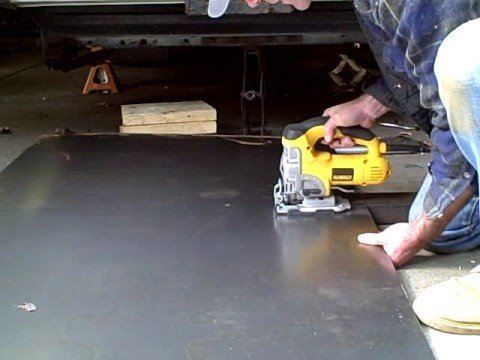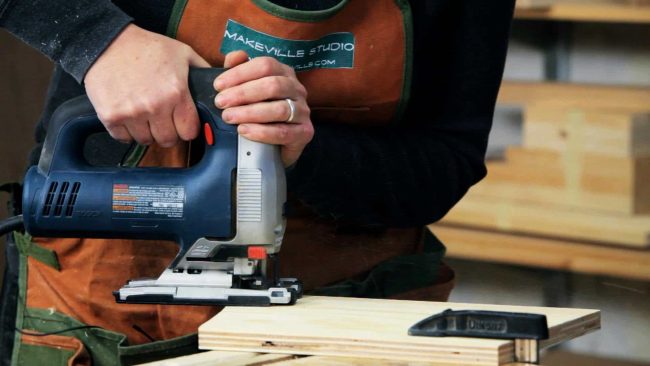How to Use a Jigsaw to Cut Sheet Metal, Wood, & Tile
Do you know that most of the pros & DIYers make use of a jigsaw to make directly or intricate curved cuts for any kind of carpentry task or generating crafts? Why?
How to Use a Jigsaw to Cut Sheet Metal, Wood, & Tile
A jigsaw is one of the simples to operate and versatile potential tools to cut a number of materials like lean aluminum, plastic and laminate ceramic tile, and wood. ceramic tile, and wood, because a jigsaw is one of the easy to use and versatile power instruments to cut a variety of resources like thin aluminum. You just need the right blade to do all this operate without that you will not be able to make the ideal compound and bevel cuts in panels or other materials. You have to learn the basics of utilizing a jigsaw.
A circular saw scroll saw or reciprocating saw won’t have the desired effect to cut curved facial lines in various materials.
In this article, we will teach you the way you use a jigsaw to slice sheet metal, sophisticated shapes in timber.
Cutting wood with a handheld jigsaw
For making curved or intricate shapes in the wood, any handheld jigsaw will work. You can also utilize them for crosscuts and done corners cut. They are not best to use if you want fast, and direct long cuts For that you need to use a spherical saw.
General Purpose blade
You need a general function cutting blade. You can use the one that comes with the jigsaw.
Cutting intricate styles in wood

- A jigsaw works best if softwood is max 1-½ inch thick and hardwood ¾. If you use it for thicker boards, the blade will bend. Be sure to have the sharp found blade and never force it while making the minimize.
- For making the Plunge Cut, make a cut in the middle of hardwood with a drill possibly or something else, in order that blade becomes parallel to the workpiece once you tip the jigsaw. Make sure the saw must be at when you lean it and slowly and gradually putting the blade into entry cut in the middle of the timber.
- If you want a quick minimize, the coarser blade will be good but you need to sanding work later.
- Reducing ceramic tile
- Even though there are other tools like tile nippers and ceramic rod saws to cut the ceramic tiles but they reduce slow and harm the tiles usually.
Carbide-grit ceramic blade
To slice the ceramic floor tile with a jigsaw, you require a blade of max 1/4-in. Thicker.
Cut slowly whenever using tile

You need a carbide-grit porcelain blade for ceramic tile cutting. If you are decreasing thin tiles use water to lubricate the blade and cool it down. While for the thicker types, use cutting gas for lubricating the saw cut.
Also, make sure the tile is tightened enough for your blade to work efficiently not vibrate otherwise it will break.
Decreasing Sheet metal

To slice the sheet metal with a jigsaw, you require a proper blade as much as 10 gauge thicker.
Metal Cutting Blade
You should choose a blade of up to 21 to 24 teeth for every inch to cut page metal
Clamp metal between plywood to reduce it
For keeping the sheet metal company and to avoid any rough edges, securely put the metal page between the plywood level up and down. It may take much more time to cut through the sandwich but it will be worth it.
Rather than making jump cuts, for pattern cutting, you need to drill starter holes for your blade to work sleek. Also, make sure there is enough clearance for that blade when you place the workpiece over the rail to cut over the workbench or sawhorses.
To cut metals, you must have a huge-duty discovered with features like variable speed, orbital action, and vacuum hose that you will discover only in pricey jigsaws.
Jigsaw Blade and Basics
A jigsaw (or a saber saw) cuts if the jigsaw blade is activated by pulling a trigger and the blade moves in up and down motion quickly. You need to have a specific jigsaw blade to cut the type of material like steel, tile, plastics and wood, and so forth. It all depends on the blade material that it can slice or not.
The blades should be 2 to 3-1/2 in. long for making small cuts in the little radius and 1/4 in. to 3/8 in. large for general objective cutting. They are created from carbon steel.
You might opt for 6 the teeth per inch which cut rough or 10 teeth every inch for making smoother cuts. There is a various category of jigsaw type and blades of components it can cut, all of it depends on the kind of fabric it is made from. We recommend you buy the bimetal blades because they tend to last longer and don’t break more frequently.
The blades are measured in TPI, teeth per “. More the number of the teeth, smoother the slashes. The blades with fewer teeth have a tendency to move faster therefore good for only difficult work.
Before buying a saw you must know the particular blade it comes with. This will help you to get the blades you need and carry up, rather than running out of blades while functioning. Most jigsaws feature 1/4-in. Universal blade.
Here are some functions you will find in simple and heavy-obligation jigsaws.
Variable-rate: This will help you to increase or decrease the speed of the blade based on your job. You just need to put the stress on the trigger the way you blade to perform. It is possible to slow or quit it just by discharging the trigger.
Orbital Action: There are two reducing actions in various jigsaw modes: orbital and straight. In Orbital motion, other than the conventional up and down movement of the blade, it also movements forward. This movement is useful in cutting soft materials like wood or plastic-type material. So the slashes will be less clean because it is aggressive and fast motion.
Shoes (Jigsaw Base): The shoe or base of the jigsaw is placed around the material. For making direct shoe, the blade and cuts must be at 90 degrees. While creating a bevel cut from the material, you need to adapt the angle of the shoe (body and blade are tilted against the material).
How To Properly Sharpen A Bandsaw Blade-Easy and Efficiently 2023
Strategies for Using Jigsaws
A jigsaw’s main attribute is to outgroups and scrolls, and curved shapes but it can also cut on straight lines. To help make the straight rip cut you need a very good rip fence and blade.
Here are some tips to keep in mind when learning how to make use of a jigsaw:
Don’t be in a hurry while slicing. Take your time and always remain outside of cutting like
Never make a restricted curved in a single reduce. Always use short reduction cuts so that your blade doesn’t get combine.
Make sure the workpiece won’t touch the worktable. Always raise it on the rail for your blade to work with its full potential.
Use masking tape on fine finishes
Generally, clamp wood to the bottom of the surface while cutting a lean sheet of aluminum. It will help in reducing vibration and provides a clear cut.
For making the cut in the middle of the wood, first, drill a ½ inch hole and then take advantage of the blade to begin the cut.
Jigsaw Safety
Safety is one of the most important things you need to keep in mind when using a jigsaw. When using any power device you must have all basic safety gear with you and operate in a safe manner to prevent any severe injury.
- If you are using a corded one while changing the blade always eliminate the battery in case of the cordless jigsaw and unplug it.
- Utilize the respective blade intended to cut that substance this will save you from untended kickback.
- Will not put unnecessary stress on the saw. Allow it cut at normal speed
- Make sure the jigsaw shoe is placed firmly on the surface of the workpiece
- Don’t lift the blade till they have finished cutting
- To conserve your eyes from dust particles or flying contaminants always wear basic safety glasses, Wear ear protection from loud noises.
- Wear gloves although operating and keep your hands far away from the blade
Maybe you would also like this.

Jerome T has tested home security systems in his own apartment, installed GPS trackers in his own car, and watched her cat, Toki, nap all day through a live nanny cam feed. As an expert reviewer, he believes that firsthand experience is the best way to learn about new products (even if it requires being the guinea pig).And a huge Nascar fan who loves to go camping and enjoys the outdoors.





